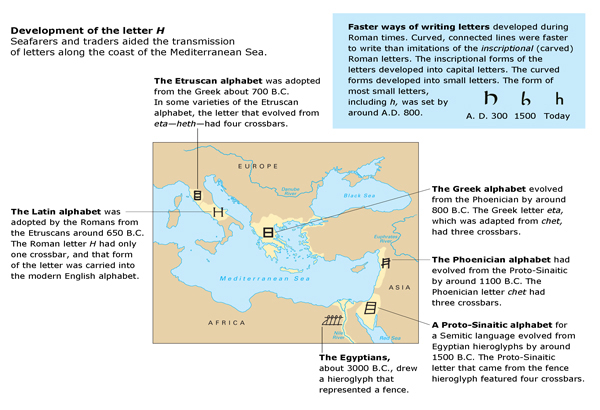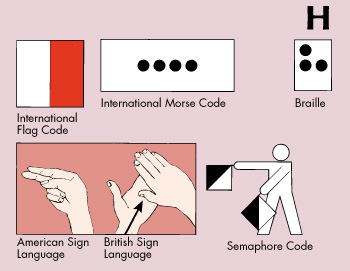H is the eighth letter of the alphabet used for the modern English language. It is also used in a number of other languages, including French, German, and Spanish. The letter H can be heard in the words hail, hit, and behind. In some words, the letter is silent, as in honor.

Scholars believe the letter H evolved from an Egyptian hieroglyph (pictorial symbol) that represented a fence. Hieroglyphs were adapted to be used for a Semitic language by around 1500 B.C. The alphabet for this Semitic language—the earliest known alphabet—is called Proto-Sinaitic. By 1100 B.C., an alphabet for another Semitic language, Phoenician, had evolved from Proto-Sinaitic. See Semitic languages .
The Phoenician letter that can be traced to the Egyptian fence hieroglyph is the eighth letter of the Phoenician alphabet, chet. The Phoenicians used the letter to represent an H sound made much farther back in the throat than is an English H.
When the Greeks adapted the Phoenician alphabet around 800 B.C., chet evolved into the Greek letter eta. The sound chet had represented, however, was not used in most dialects of Greek, so eta was mostly used for the sound of the vowel that followed the CH sound in the name of the letter chet. This sound was like EE, and the Greeks used their letter eta for it. Some dialects of ancient Greek did have an H sound, and in those eta was used to represent H. The Etruscan alphabet, which was adopted about 700 B.C., evolved from one such dialect of ancient Greek. The Etruscans used eta for the H sound, as did the Romans, who adopted the Etruscan alphabet by around 650 B.C. But the Romans also used H in combinations to write Greek words—for example, TH for the letter theta, PH for phi, and CH for chi, all of which had a puff of air (an H sound) after them in Greek.

See also Alphabet .
